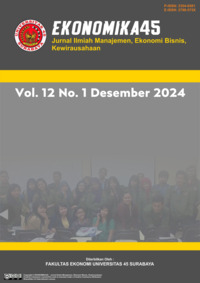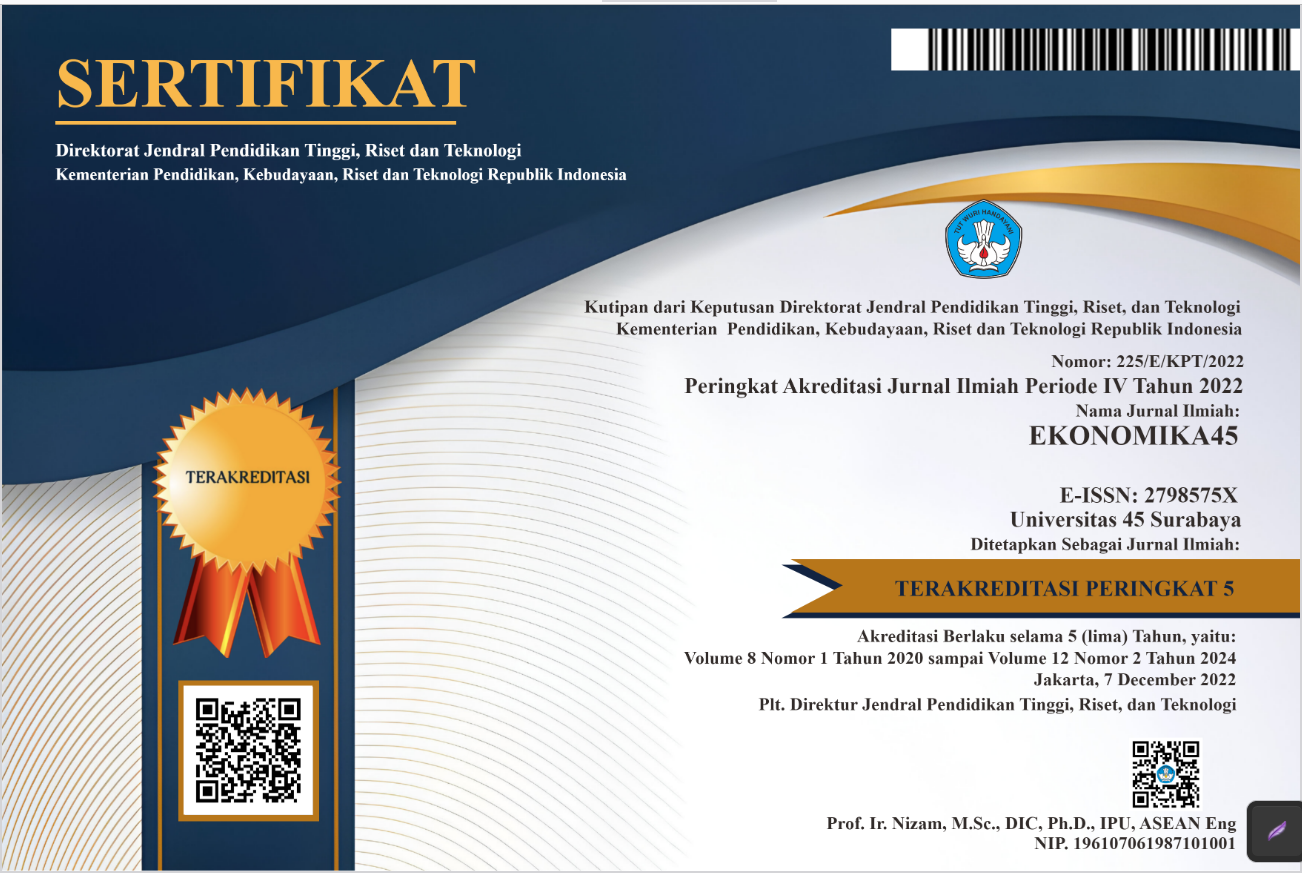Pengaruh Dana Bagi Hasil, Dana Alokasi Umum, Dana Alokasi Khusus, Dana Otonomi Khusus, Dana Desa, dan Belanja Daerah terhadap Kemiskinan di Kawasan Papua
DOI:
https://doi.org/10.30640/ekonomika45.v12i1.3564Keywords:
Regional expenditure, special allocation funds, general allocation funds, profit-sharing funds, village funds, special autonomy fundsAbstract
Poverty is a complex and multidimensional problem. Papua is an area that has the highest poverty conditions in Indonesia. This research uses panel data consisting of the provinces of Papua and West Papua for the period 2008-2022. The analysis technique used is panel data regression. The results of the analysis show that profit sharing funds and village funds have a negative and significant effect on poverty in Papua. General allocation funds and special allocation funds have a positive and significant effect on poverty. Special autonomy funds and regional spending have no effect on poverty in Papua. The implication of this research is the need to optimize the realization of DAU, DAK, Special Autonomy Funds, and Regional Expenditures so as to reduce poverty levels.
References
Arham, M. A., & Rauf, H. A. T. U. (2020). Does village fund transfer address the issue of inequality and poverty? A lesson from Indonesia. The Journal of Asian Finance, Economics and Business (JAFEB), 10(7), 433–422.
Aziz Sholeh, Abdul et al. (2024). Kompensasi Terhadap Motivasi Kerja Karyawan pada PT. Insolent Raya di Surabaya. Journal of Management and Creative Business, 2(1), 82–96.
Aziz, N. L. L. (2017). The Village Autonomy and The Effectiveness of Village Fund. Jurnal Penelitian Politik, 13(2), 193–211.
Budiratna, H., & Qibthiyyah, R. M. (2020). Evaluasi Atas Transfer Dana Otonomi Khusus Di Aceh, Papua, Dan Papua Barat. Jurnal Indonesia Sosial Sains, 1(5), 1–13.
Ghozali, I. (2018). Aplikasi Analisis Multivariate Dengan Program SPSS. Badan Penerbit Universitas Diponegoro.
Ghozali, I., & Khoirunurrofik. (2020). Fiscal decentralisation and capital expenditure composition of regional government in Indonesia. International Journal of Trade and Global Markets, 13(1), 81–88. https://doi.org/10.1504/IJTGM.2020.104909
Granado, F. J. A., Martinez-Vazquez, J., & McNab, R. M. (2018). Decentralized governance, expenditure composition, and preferences for public goods. Public Finance Review, 46(3), 359–388.
Gujarati, D. (2013). Ekonometrika Dasar. Erlangga.
Gumelar, A. (2021). Analisis Pengaruh Dana Perimbangan Terhadap Tingkat Kemiskinan (Studi Kasus Kabupaten/Kota di Sulawesi Tengah). Jurnal Ekonomi-QU, 11(2), 342–364.
Hanif, I., Sharif Chaudhry, I., & Wallace, S. (2014). Fiscal Autonomy and Economic Growth Nexus: Empirical Evidence from Pakistan. Pakistan Journal of Social Sciences (PJSS), 34, 767–780.
Hastuti, P. (2018). Desentralisasi Fiskal dan Stabilitas Politik dalam Kerangka Pelaksanaan Otonomi Daerah di Indonesia. Simposium Nasional Keuangan Negara, 784–799.
Ika, N., Fitriyanti, & Handayani, H. R. (2020). Pengaruh Pendapatan Asli Daerah (PAD), Dana Alokasi Khusus (DAK), Dan Belanja Daerah Terhadap Tingkat Kemiskinan (Studi Kasus 35 Kabupaten/Kota Di Provinsi Jawa Tengah Tahun 2012-2016). Diponegoro Journal of Economics, 9(2), 79–90. https://ejournal2.undip.ac.id/index.php/dje
Ismail, A., & Hakim, A. (2014). Peran Dana Perimbangan Terhadap Kemiskinan di Provinsi Bali. Aplikasi Bisnis, 9(15), 173–175.
Kadafi, M., & Murtala, M. (2020). Pengaruh Pendapatan Asli Daerah, Dana Alokasi Umum Dan Dana Otonomi Khusus Terhadap Tingkat Kemiskinan Di Provinsi Aceh Periode 2010-2017. Jurnal Ekonomi Regional Unimal, 3(2), 23. https://doi.org/10.29103/jeru.v3i2.3203
Khusaini, M. (2014). Local government planning and budgeting process: A case of districts and cities in Indonesia. International Journal of Economic Policy in Emerging Economies, 7(2), 141–156. https://doi.org/10.1504/IJEPEE.2014.063190
Kristiawati, et al. (2019). Citra Merek Persepsi Harga dan Nilai Pelanggan Terhadap Keputusan Pembelian Pada Mini Market Indomaret Lontar Surabaya. Jurnal Ilmu Ekonomi dan Manajemen (JMM 17), 6(2), 27–36.
Lucia, M., Walewangko, E., & Pingkan, I. (2023). Analisis Pengaruh Pertumbuhan Ekonomi, Belanja Daerah, dan PAD Terhadap Kemiskinan di Kabupaten Minahasa. Jurnal Berkala Ilmiah Efesiensi, 23(7), 37–48.
Manduapessy, R. L. (2020). Pengaruh Pendapatan Asli Daerah (PAD), Dana Perimbangan Terhadap Pertumbuhan Ekonomi Dan Kemiskinan Di Kabupaten Mimika. Jurnal Kritis, 4, 39–57.
Mardiansyah, N., Abdul, A. A., & Suharno. (2023). The Influence of General Allocation Funds, Special Allocation Funds, Revenue Sharing Funds, and Village Funds on Poverty in the Special Region of Yogyakarta Province. MYIC, 182–196.
Mudrajad, K. (2004). Otonomi & Pembangunan Daerah Reformasi, Perencanaan, Strategi, dan Peluang. Erlangga.
Nany, M., Pratama, D. B., Prasetyaningrum, M., & ... (2022). Pengaruh PAD, DBH, DAU, DAK Dan Belanja Daerah Terhadap Kemiskinan Di Jawa Tengah. Jurnal Ekonomi, 22(3), 247–261.
Permai, S. D., Christina, A., & Santoso Gunawan, A. A. (2021). Fiscal decentralization analysis that affect economic performance using geographically weighted regression (GWR). Procedia Computer Science, 179, 399–406. https://doi.org/10.1016/j.procs.2021.01.022
Ramírez, J. M., Díaz, Y., & Bedoya, J. G. (2017). Property Tax Revenues and Multidimensional Poverty Reduction in Colombia: A Spatial Approach. World Development, 94, 406–421. https://doi.org/10.1016/j.worlddev.2017.02.005
Sambanis, N., & Milanovic, B. (2014). Explaining Regional Autonomy Differences in Decentralized Countries. Comparative Political Studies, 47(13), 1830–1855. https://doi.org/10.1177/0010414013520524
Siburian, M. E. (2022). The link between fiscal decentralization and poverty – Evidence from Indonesia. Journal of Asian Economics, 81(101493).
Sigit, T. A., & Kosasih, A. (2020). Pengaruh Dana Desa terhadap Kemiskinan: Studi Tingkat Kabupaten/Kota di Indonesia. Indonesian Treasury Review Jurnal Perbendaharaan Keuangan Negara dan Kebijakan Publik, 5(2), 105–119. https://doi.org/10.33105/itrev.v5i2.170
Solomon, B. D. (2023). Sustainable Development Goals (SDGs) dan Pengentasan Kemiskinan. Dictionary of Ecological Economics: Terms for the New Millennium, 42, 526–527. https://doi.org/10.4337/9781788974912.S.104
Susilowati, N. I., Susilowati, D., & Hadi, S. (2017). Pengaruh Alokasi Dana Desa, Dana Desa, Belanja Modal, Dan Produk Domestik Regional Bruto Terhadap Kemiskinan Kabupaten/Kota Di Jawa Timur. Jurnal Ilmu Ekonomi, 1, 514–526.
Tobing, M. (2021). Pengaruh Jumlah Obyek Wisata, Tingkat Penghunian Kamar, Dan Jumlah Kunjungan Wisatawan Terhadap Pendapatan Asli Daerah Kabupaten Simalungun. Jurnal Ekuilnomi, 3(2), 127–139. https://doi.org/10.36985/ekuilnomi.v3i2.263
Todaro, M. P., & Smith, S. C. (2014). Pembangunan Ekonomi. Erlangga.
Widianto, A., Sedya, U., & Langgeng Nurmansyah, A. (2016). Pengaruh Dana Alokasi Umum, Dana Alokasi Khusus, Dan Belanja Modal Terhadap Pertumbuhan Ekonomi Dan Tingkat Kemiskinan (Studi Kasus Pada Kota Tegal). Journal Research Accounting Politeknik Tegal, 5(2), 170–176.
Wijaya, D. N., Arifin, Z., & Hadi, S. (2018). Pengaruh Dana Desa, Alokasi Dana Desa Dan Dana Alokasi Umum Terhadap Kemiskinan Di Provinsi Jawa Timur Tahun 2015-2016. Jurnal Ilmu Ekonomi, 2(1), 156–166.
Downloads
Published
How to Cite
Issue
Section
License
Copyright (c) 2024 EKONOMIKA45 : Jurnal Ilmiah Manajemen, Ekonomi Bisnis, Kewirausahaan

This work is licensed under a Creative Commons Attribution-ShareAlike 4.0 International License.









